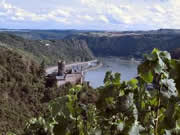 The regional finals for this year's guide book began at Im Schiffchen in Rhens yesterday morning with the Mittelrhein. The trick for all of the estates to solve in 2010 was clearly how to handle the high natural acidities that the vintage brought forth. The best producers harvested quite late, but that was often not sufficient. The regional finals for this year's guide book began at Im Schiffchen in Rhens yesterday morning with the Mittelrhein. The trick for all of the estates to solve in 2010 was clearly how to handle the high natural acidities that the vintage brought forth. The best producers harvested quite late, but that was often not sufficient.
Many deacidified their musts and some again the wine as well, which was certainly not a recipe for success. Surprisingly, but perhaps understandable as many had never in their careers needed to correct acidities, a number overshot the mark. Not unusual either was the attempt to use partial malolactic conversions to soften the palate feel, but that does not work so well with Riesling unless it happens during fermentation. Peter Jacob Kuhn, of course, preaches that no wine has achieved its natural balance unless it has 'processed' its unstable malic acidity. As all too often in recent years, almost all estates have also used whatever residual sugars the law allows to poise the bracing acidities, but that often reduces, at least in their youth, that wines inherent drinkability. That said, where claret needs years to soften its austere tannins, German Riesling often needs a similar amount of time to 'dry out' its residual sugars. Many estates were not up to the challenge - and the finest Rieslings across the board were not dry or off-dry, although Matthias Müller hit the mark on the latter, but the succulent spätlese. Apparently, few producers still have a much of a market for noble late harvest wines as, other than a single trockenbeerenauslese from Weingart, there was not much of that ilk shown. Comments |